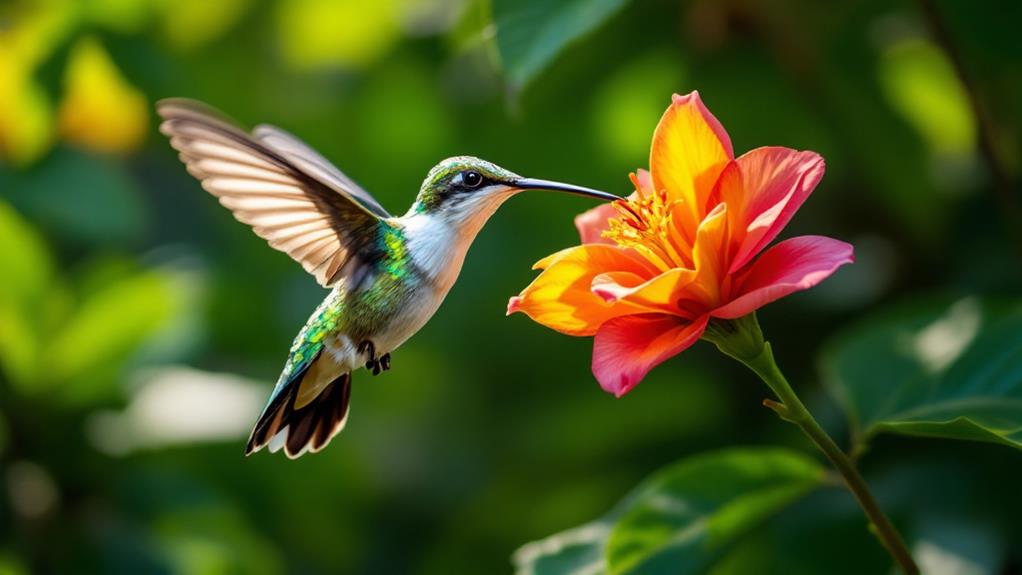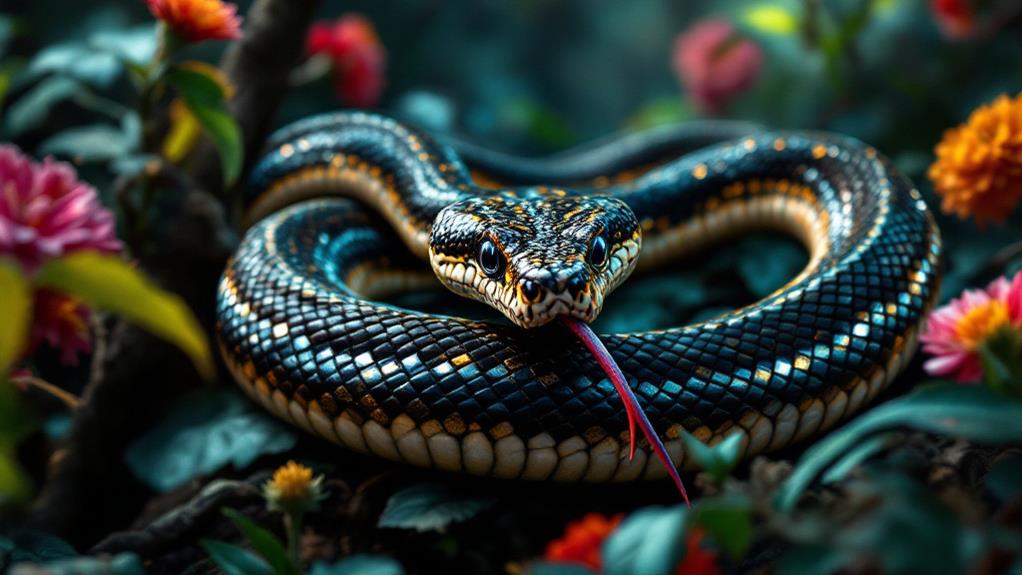The Smallest Mammals in the World: Tiny Creatures With Big Impact
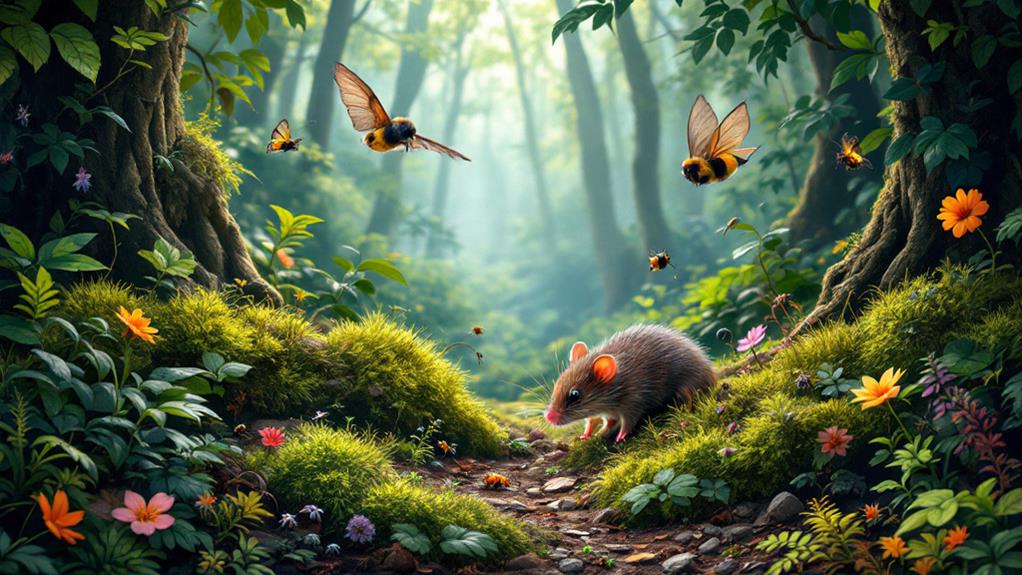
You'd be surprised how the world's smallest mammals make a big impact. The Etruscan shrew, weighing just 1.8 grams, has a high metabolism that requires it to eat double its weight daily. The bumblebee bat, found in Asian caves, showcases expert flying and hunting via echolocation. In the deserts of Central Asia, the pygmy jerboa plays a key ecological role by dispersing seeds. Madagascar's pygmy mouse lemur and Australia's tiny paucident planigale add to the ecological balance. These tiny creatures face threats like habitat loss and climate change, but there's more to uncover about their fascinating adaptations and roles.
Understanding the Etruscan Shrew
Often overlooked in the animal kingdom, the Etruscan shrew is a fascinating creature to investigate. As the smallest mammal by mass, this tiny animal boasts remarkable adaptations that guarantee its survival. Weighing just about 1.8 grams, its small size is an adaptation in itself, allowing it to squeeze through narrow spaces in search of food. You'll find its sense of smell is incredibly developed, a crucial trait for locating prey in the dark habitats it often inhabits. Its high metabolism demands an enormous amount of energy, which is why it consumes up to twice its body weight daily. This brings us to the Etruscan shrew diet.
The Etruscan shrew relies heavily on a carnivorous diet, primarily consisting of insects, spiders, and other small invertebrates. Its sharp teeth are perfectly adapted for capturing and devouring prey swiftly. To meet its intense energy needs, the shrew hunts almost nonstop, its rapid movements and acute senses aiding in the detection and capture of food. By comprehending these adaptations and dietary habits, you gain insight into how such a small creature thrives in its ecosystem, showcasing the incredible diversity and specialization within the animal kingdom.
Bumblebee Bat: World's Smallest
Imagine holding a creature that fits snugly within the confines of your palm—that's the bumblebee bat, also known as Kitti's hog-nosed bat. Weighing in at just two grams and measuring roughly 1.1 to 1.3 inches in length, it holds the title of the world's smallest mammal. Found in the limestone caves of Thailand and Myanmar, these bats are masters of their niche environment.
When you observe bat behavior, you'll notice that bumblebee bats are social creatures, often roosting in colonies that can number up to 100 individuals. They emerge at dusk, fluttering through the dense forests using their efficient flight mechanics. Their wings, wide and short, allow them to hover and maneuver with precision, much like a hummingbird. This agility aids them in capturing insects, their primary food source, as they zip through the air.
Understanding their flight mechanics reveals how they adapt to their environment. By emitting high-pitched echolocation calls, they navigate and hunt, despite their tiny stature. Protecting these fascinating creatures is essential, as they play an important role in maintaining ecological balance by controlling insect populations and contributing to pollination. Your awareness can help guarantee their survival.
Pygmy Jerboa: Desert Dweller
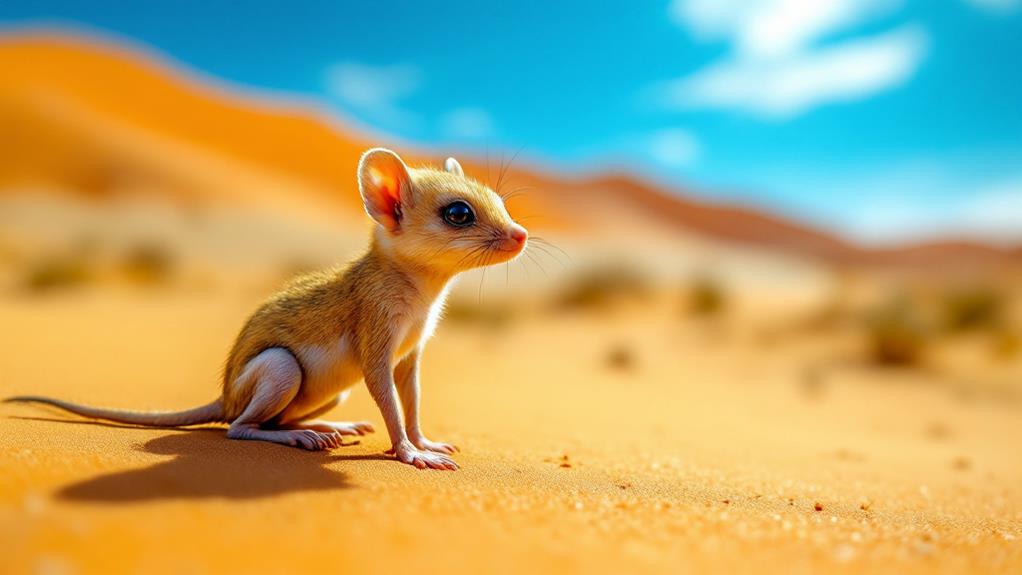
While the bumblebee bat rules the skies, the pygmy jerboa claims its tiny throne on the ground. In the vast, arid deserts of Central Asia, this miniature marvel thrives, demonstrating exceptional habitat adaptation. You'll find it fascinating how these tiny creatures survive where temperatures fluctuate dramatically. Their long hind legs aren't just for show; they're perfect for hopping across sandy dunes, helping them escape predators and travel efficiently in search of food.
The pygmy jerboa's foraging behavior is a marvel of nature. They primarily eat seeds and insects, employing their keen sense of smell to locate sustenance hidden beneath the sand's surface. Despite their size, they play a significant role in their ecosystem by dispersing seeds, inadvertently aiding in plant propagation. You'll be amazed to see how these tiny mammals contribute to maintaining the delicate balance of their harsh environment.
Furthermore, the pygmy jerboa's nocturnal habits guarantee they avoid the scorching daytime heat. Their burrowing skills are exceptional, creating cozy underground homes that provide shelter and regulate temperature. With their unique adaptations and foraging skills, pygmy jerboas exemplify nature's ingenuity in tackling the challenges of desert life.
Madagascar's Pygmy Mouse Lemur
Situated within the dense forests of Madagascar, the pygmy mouse lemur is among the tiniest primates in the world, enchanting nature enthusiasts with its diminutive size and lively eyes. Weighing in at just about 30 grams, these nocturnal creatures captivate with their unique adaptations and intriguing mouse lemur behavior. As night falls, their large eyes come alive, perfectly adapted to low-light conditions, allowing them to navigate the dark forest with ease.
You'll find that these tiny primates are not only great climbers but also excellent jumpers. Their long tails aid in balance as they leap from branch to branch, searching for insects, fruits, and nectar. This varied diet supports their high metabolism, essential for their active nighttime lifestyle. Mouse lemur behavior is fascinating; they exhibit social tendencies, often seen grooming each other or sharing nests to conserve warmth.
What's remarkable is their ability to enter torpor, a state akin to hibernation, helping them survive when food becomes scarce. This adaptation showcases their resilience in Madagascar's challenging environment. Despite their small size, pygmy mouse lemurs play a big role in their ecosystem, acting as both predator and prey, maintaining the delicate balance of their forest home.
Paucident Planigale Insights
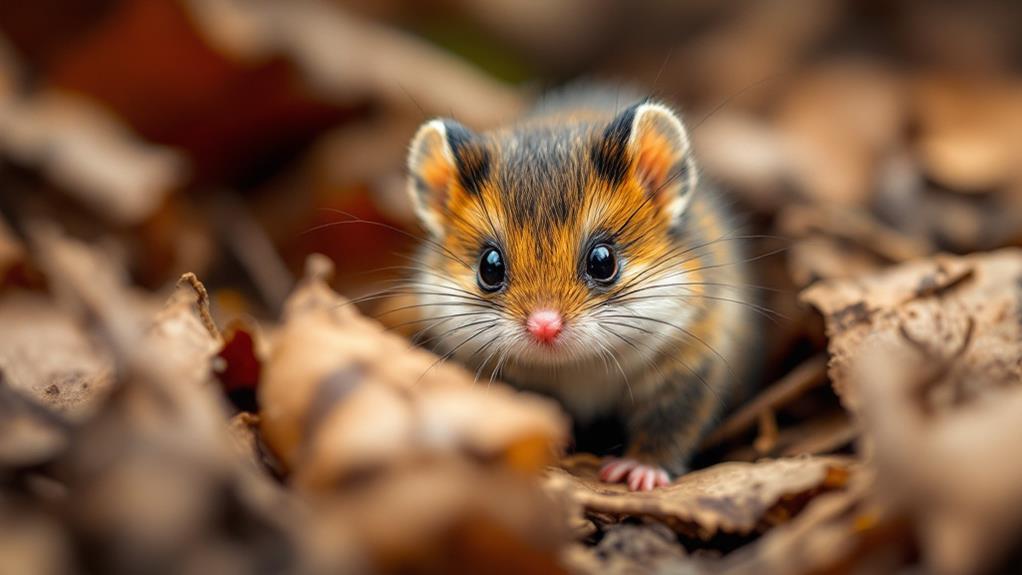
Delving into the world of the paucident planigale, you'll uncover one of the smallest and most intriguing marsupials on the planet. Weighing only a few grams and measuring about 55-65 millimeters in length, these tiny creatures might be easily overlooked in their natural habitat. Yet, their behavior is nothing short of fascinating. The paucident planigale, despite its size, is a formidable predator. You'd be amazed at its agility and speed when it hunts small insects and invertebrates. It employs a surprising burst of energy to catch its prey, showcasing endurance that belies its tiny stature.
Exploring the paucident planigale habitat, you'll find these marsupials thriving in the arid and semi-arid regions of Australia, particularly in areas with dense ground cover. Their preferred environment includes grassy woodlands and scrublands, where they can quickly scurry through the underbrush. This habitat not only provides ample food sources but also offers protection from larger predators. The planigale has adapted remarkably well to its surroundings, making use of its environment to remain elusive and efficient. By understanding the paucident planigale behavior and habitat, you gain insight into how these small creatures play a significant role in their ecosystem.
Conservation Challenges Faced
Understanding the behavior and habitat of the paucident planigale sheds light on the challenges they face in the wild. Habitat loss due to urban expansion and agriculture disrupts their living spaces, leaving them vulnerable. Climate change further exacerbates these issues, altering their environment faster than they can adapt. Invasive species pose another threat, as they compete for food and resources, pushing the planigales out of their natural habitats.
You might wonder what's being done to protect these tiny creatures. Conservation efforts are underway, but they face hurdles such as limited research funding. Without adequate financial support, it's tough to conduct the necessary studies to understand the full impact of these threats. Raising public awareness is essential, as it can lead to more robust support for species protection initiatives.
Genetic diversity is another concern. With shrinking populations, maintaining a healthy gene pool becomes challenging, increasing the risk of inbreeding and disease. By supporting conservation efforts and promoting public awareness, you can help create a safer environment for the paucident planigale. Protecting their habitat and ensuring their survival require collective action and ongoing dedication. Your involvement can make a significant difference in their continued existence.
Ecological Roles and Importance
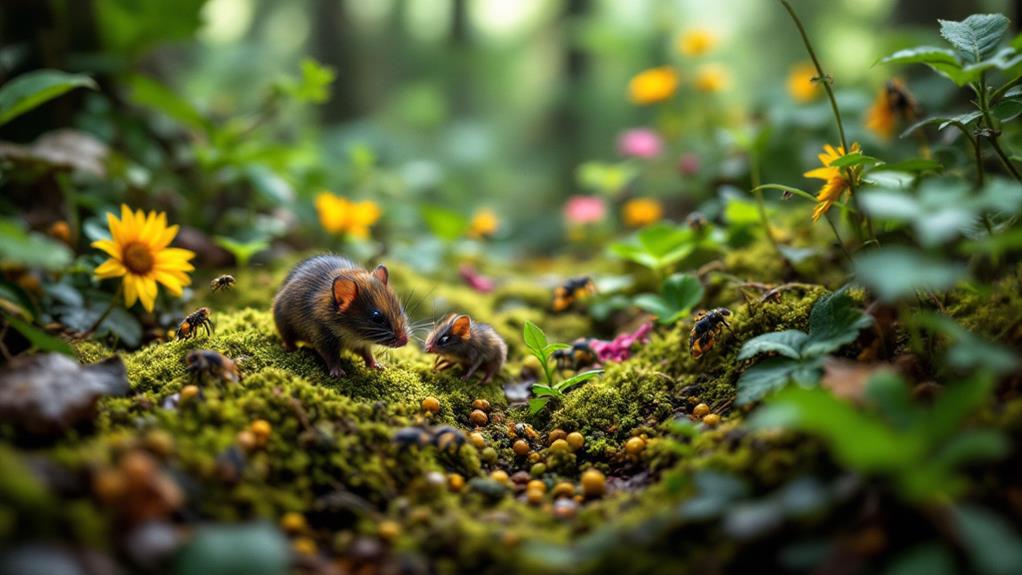
Amidst the diverse tapestry of life, the paucident planigale plays an vital role in its ecosystem. You might not realize it, but these tiny mammals act as pivotal drivers of ecological balance. They contribute to nutrient cycling by breaking down organic material, which enriches the soil and supports plant growth. This, in turn, aids in seed dispersal, ensuring that a variety of plant species thrive and maintain habitat diversity.
These little creatures also serve as significant players in food web dynamics. As both prey and predator, the paucident planigale maintains population control among insects and smaller species, which prevents any one group from dominating the ecosystem. This balance supports climate resilience, as a diverse ecosystem can better withstand environmental changes.
Furthermore, tiny mammals like the paucident planigale can be seen as biodiversity indicators. Their presence signifies a healthy ecosystem, where pollination services and habitat engineers work in harmony. By sustaining these small creatures, you're indirectly supporting a wide range of ecological processes that benefit the entire community. So next time you think of small mammals, remember their big impact on maintaining the delicate web of life around them.
Protecting Tiny Mammal Habitats
Safeguarding the habitats of tiny mammals like the paucident planigale is crucial for preserving biodiversity. You can play an important role in habitat preservation by understanding the significance of land management and conservation strategies. These small creatures depend on specific environments to thrive, and any imbalance can lead to their decline. By taking proactive measures, you contribute to species protection and the comprehensive health of ecosystems.
Consider these actions to support tiny mammal habitats:
- Adopt sustainable land management practices: Confirm that land is used efficiently and responsibly, reducing habitat destruction.
- Engage in ecosystem restoration projects: Participate in efforts to restore natural habitats by planting native vegetation and removing invasive species.
- Support conservation strategies: Advocate for policies that protect critical habitats and promote biodiversity.
- Promote environmental education: Raise awareness about the importance of these tiny mammals and the challenges they face.
Through these efforts, you not only help protect the smallest mammals but also maintain ecological balance. Every action counts, and your involvement can lead to substantial improvements in preserving these significant habitats. Remember, protecting tiny creatures leads to a healthier planet for all.
